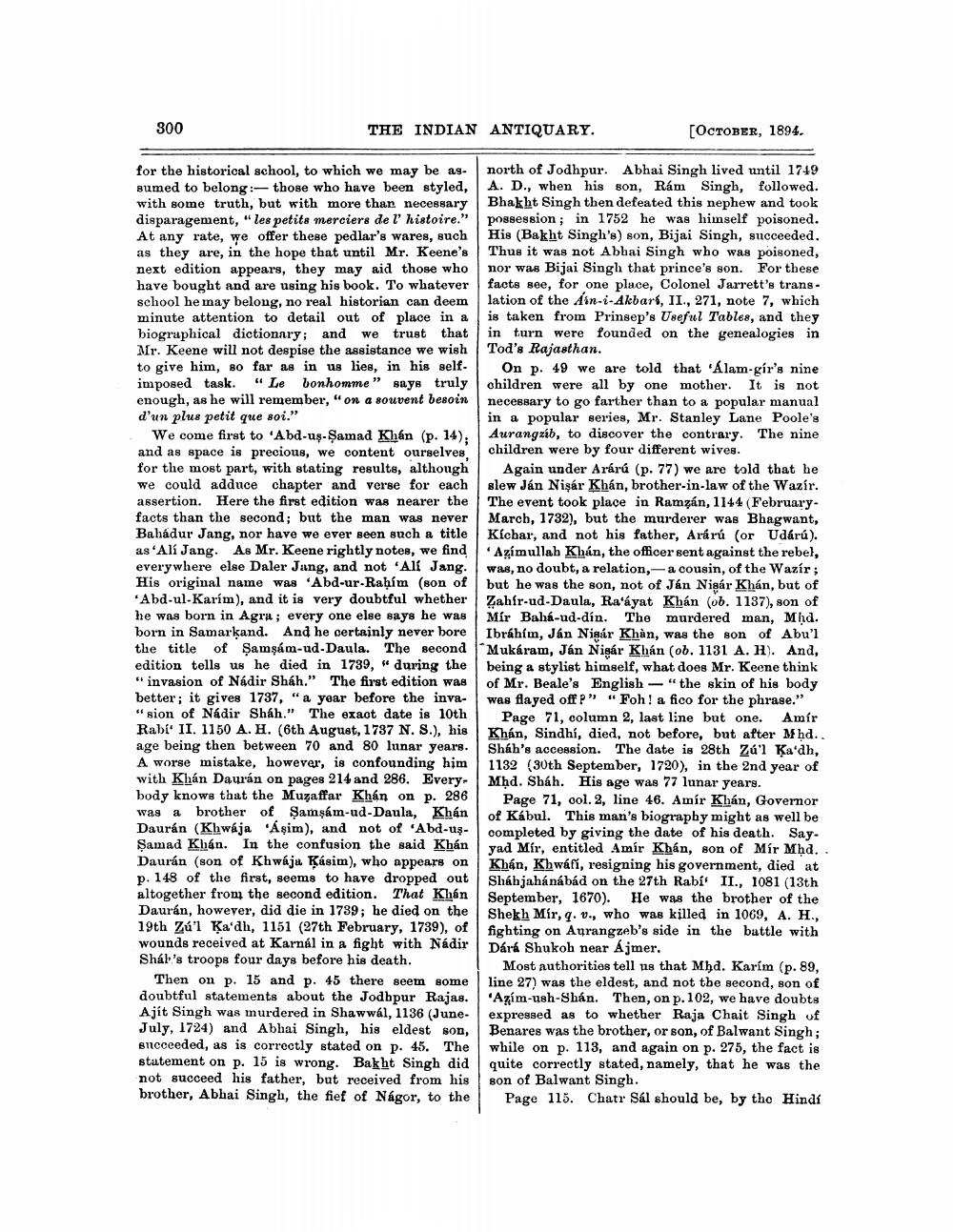________________
800
THE INDIAN ANTIQUARY.
for the historical school, to which we may be assumed to belong:- those who have been styled, with some truth, but with more than necessary disparagement, "les petits merciers de l' histoire." At any rate, we offer these pedlar's wares, such as they are, in the hope that until Mr. Keene's next edition appears, they may aid those who have bought and are using his book. To whatever school he may belong, no real historian can deem minute attention to detail out of place in a biographical dictionary; and we trust that Mr. Keene will not despise the assistance we wish to give him, so far as in us lies, in his selfimposed task. "Le bonhomme" says truly enough, as he will remember, "on a souvent besoin d'un plus petit que soi."
We come first to 'Abd-us-Samad Khán (p. 14); and as space is precious, we content ourselves, for the most part, with stating results, although we could adduce chapter and verse for each assertion. Here the first edition was nearer the. facts than the second; but the man was never Bahadur Jang, nor have we ever seen such a title as 'Alí Jang. As Mr. Keene rightly notes, we find everywhere else Daler Jang, and not 'Ali Jang. His original name was 'Abd-ur-Raḥím (son of 'Abd-ul-Karím), and it is very doubtful whether he was born in Agra; every one else says he was born in Samarkand. And he certainly never bore the title of Samsám-ud-Daula. The second edition tells us he died in 1739, "during the "invasion of Nádir Sháh." The first edition was better; it gives 1737, "a year before the inva"sion of Nádir Sháh." The exact date is 10th Rabi' II. 1150 A. H. (6th August, 1737 N. S.), his age being then between 70 and 80 lunar years. A worse mistake, however, is confounding him with Khán Daurán on pages 214 and 286. Everybody knows that the Muzaffar Khán on p. 286 was a brother of Samsám-ud-Daula, Khán Daurán (Khwaja Áşim), and not of 'Abd-usSamad Khán. In the confusion the said Khán Daurán (son of Khwaja Kásim), who appears on p. 148 of the first, seems to have dropped out altogether from the second edition. That Khán Daurán, however, did die in 1739; he died on the 19th Zú'l Ka'dh, 1151 (27th February, 1739), of wounds received at Karnál in a fight with Nádir Shál's troops four days before his death.
Then on p. 15 and p. 45 there seem some doubtful statements about the Jodhpur Rajas. Ajit Singh was murdered in Shawwál, 1136 (JuneJuly, 1724) and Abhai Singh, his eldest son, succeeded, as is correctly stated on p. 45. The statement on p. 15 is wrong. Bakht Singh did not succeed his father, but received from his brother, Abhai Singh, the fief of Nágor, to the
[OCTOBER, 1894.
north of Jodhpur. Abhai Singh lived until 1749 A. D., when his son, Rám Singh, followed. Bhakht Singh then defeated this nephew and took possession; in 1752 he was himself poisoned. His (Bakht Singh's) son, Bijai Singh, succeeded. Thus it was not Abhai Singh who was poisoned, nor was Bijai Singh that prince's son. For these facts see, for one place, Colonel Jarrett's translation of the Ain-i-Akbars, II., 271, note 7, which is taken from Prinsep's Useful Tables, and they in turn were founded on the genealogies in Tod's Rajasthan.
On p. 49 we are told that 'Alam-gír's nine children were all by one mother. It is not necessary to go farther than to a popular manual in a popular series, Mr. Stanley Lane Poole's Aurangzib, to discover the contrary. The nine children were by four different wives.
Again under Arárú (p. 77) we are told that he slew Ján Nişár Khán, brother-in-law of the Wazír. The event took place in Ramzán, 1144 (FebruaryMarch, 1732), but the murderer was Bhagwant, Kíchar, and not his father, Arárú (or Udárú). Azímullah Khán, the officer sent against the rebel, was, no doubt, a relation,- a cousin, of the Wazir; but he was the son, not of Ján Nisár Khán, but of Zahir-ud-Daula, Ra'áyat Khán (ob. 1137), son of Mír Bahá-ud-dín. The murdered man, Mhd. Ibráhím, Ján Nigár Khàn, was the son of Abu'l Mukáram, Ján Nigár Khán (ob. 1131 A. H). And, being a stylist himself, what does Mr. Keene think of Mr. Beale's English - "the skin of his body was flayed off?" Foh! a fico for the phrase."
Page 71, column 2, last line but one. Amír Khán, Sindhí, died, not before, but after Mhd.. Shah's accession. The date is 28th Zú'l Ka'dh, 1132 (30th September, 1720), in the 2nd year of Mhd. Sháh. His age was 77 lunar years.
Page 71, col. 2, line 46. Amír Khán, Governor of Kábul. This man's biography might as well be completed by giving the date of his death. Sayyad Mír, entitled Amir Khán, son of Mír Mhd.. Khán, Khwáfí, resigning his government, died at Shahjahánábád on the 27th Rabí II., 1081 (13th September, 1670). He was the brother of the Shekh Mir, q. v., who was killed in 1069, A. H., fighting on Aurangzeb's side in the battle with Dárá Shukoh near Ajmer.
Most authorities tell us that Mhd. Karím (p. 89, line 27) was the eldest, and not the second, son of 'Azim-ush-Shán. Then, on p. 102, we have doubts expressed as to whether Raja Chait Singh of Benares was the brother, or son, of Balwant Singh; while on p. 113, and again on p. 275, the fact is quite correctly stated, namely, that he was the son of Balwant Singh.
Page 115. Chatr Sál should be, by the Hindí




